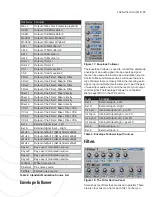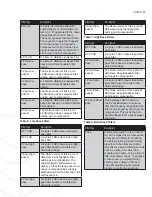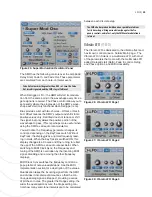
10
| SOUND SOURCES
Multimode Oscillators
(MM)
Figure 1: Multimode Oscillator Pair
Each MultiMode Oscillator (MM Osc) has several wave-
shapes, and in fact, there are several different oscillator
types ‘hidden’ within the MM Osc structure. Also, there
are slight differences between MM Osc 1 and MM Osc
2. Here are the available waveshapes for each:
MM OSC 1
MM OSC 2
Sine Sine
Triangle Triangle
Saw Up (ramp)
Saw Up (ramp)
Saw Down
Saw Down
Pulse Pulse
White Noise
Pink Noise
MorphSaw
MorphSaw (not in MIDI Clk
mode)
MorphSquare
MorphSquare (not in MIDI Clk
mode)
SuperSaw
SuperSaw (not in MIDI Clk
mode)
Multimode Oscillator Waveshapes
Table 3:
MorphSaw/MorphSquare – when the Initial Shape
parameter is zero, these output a sine wave. As the
Shape is increased (+/-), the waveshape becomes
more ‘saw’ or ‘square’ shaped.
SuperSaw is a ‘brute force’ attempt to provide a highly
detuned saw mix - it actually uses 7 saw oscillators
progressively detuned from one another.
There are some differences in how MM Osc 2 is used,
and therefore, some ‘special case’ situations occur.
Since the origins of the Solaris come from the Orion
Custom (which borrowed the Prophet 5 concept for
Osc 2 modulation), you will
fi
nd that the MM Osc 2 ap-
pears in the modulation lists in 2 forms - unaltered and
shaped:
Whenever you see ‘MMosc 2’ in the
•
modulation
source lists, it is the unaltered MM Osc 2 output.
Whenever you see ‘EnOsc2’ or ‘EnvOsc 2’, it is the
•
output of MM Osc 2 with its amplitude shaped by
Envelope Generator 1 (EG1).
For MMosc 2, when using MIDI Clock, I assumed the
user would want more precise control over the onset of
waveshape events, to allow better modulation synchro-
nization by being able to retrigger the phase (which is a
way to determine where in the cycle of the waveshape
the modulation will start on a note-on event). Also,
when switching control to MIDI Clock control, keyboard
tracking is turned off and setting to a low frequency
range is done, both automatically. Therefore, these two
buttons disappear. Instead, a Retrig button is dis-
played, which allows the user to control the phase start
point with a note-on event. Also, the displays change to
MIDI Clock Division list and a Phase knob (which only
matters if Retrig is on).
Figure 2: MIDI clock sync for MM OSC 1
However, the actual structure of the MM Oscillator
circuit does not internally provide for phase retrigger-
ing. So, to provide this I had to ‘switch out’ the regular
MM Osc 2 circuit for a retriggerable LFO, which does
not provide all of the same waveshapes as the MM
Osc 2. This is why you will not see certain names in
the waveshape list when using MM Osc 2 under MIDI
Clock control.
Sound Sources











































